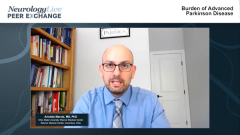
Burden of Advanced Parkinson Disease
Aristide Merola, MD, PhD, leads a discussion about the burden and impairment on the quality of life for patients with advanced Parkinson disease.
Episodes in this series

Adolfo Ramirez-Zamora, MD: Ari, how do you see the presence of nonmotor symptoms? How does that fit into the definition of advanced Parkinson disease? As we know, sometimes these nonmotor concerns are the leading source of functional disability or impairment for some of these patients. Do you typically talk about that to patients as well? How do you assess this? What do you think about this?
Aristide Merola, MD, PhD: Absolutely. I think that’s a very good point. I think the definition of advanced Parkinson disease was very biased 20, 30 years ago, by the fact that new therapies came out. We had advanced therapies such as deep brain stimulation. So, we tend to identify the definition of advanced Parkinson disease with the stage in which patients can benefit from an advanced therapy. Once patients start to have motor fluctuations, at that point we say, “OK, this is the moment to consider an advanced therapy such as deep brain stimulation,” and so we can call this advanced or advancing Parkinson disease.
But again, the concept is changing because it’s not just a matter of motor fluctuations, it’s also becoming a matter of nonmotor symptoms and fluctuations. If we look from the perspective of the disease, we can potentially call advancing Parkinson disease any condition in which it’s not just a matter of taking a pill and controlling the symptoms, but where we start having symptoms that have an impact on quality of life. We start having symptoms that may require more complex therapy, a more multidisciplinary approach, and that’s probably one other way to define advanced Parkinson disease.
Adolfo Ramirez-Zamora, MD: Thank you for that. Now that I have you on that topic, would you also comment a little on what’s the burden and the impairment on quality of life in advanced Parkinson disease? What would be important to recognize in that timeline, when patients are having significant impairment, so we can adjust therapies or start thinking about advanced therapies?
Aristide Merola, MD, PhD: Sure. Yes, it’s true that we started defining Parkinson disease back in the day based on the objective science that we as neurologists could perceive, for instance, unilateral disease, bilateral disease, severity of motor symptoms. But right now, we are moving toward the direction in which it’s a matter of a patient’s perspective. It’s becoming more important to analyze quality of life. It doesn’t really matter how much a therapy makes us doctors happy; it’s more important how much this therapy has an impact on the patient’s quality of life. Defining quality of life in Parkinson disease is not easy. There are multiple ways to approach it, multiple lines that need to be checked. We’re talking about mobility, independence in activities of daily living, emotional well-being, the stigma associated with the disease, social support, and cognitive impairment. The quality-of-life scales for Parkinson disease need to be multidimensional and analyze all of these different aspects.
Adolfo Ramirez-Zamora, MD: That’s great, that’s a good point. I can think of a couple of instances where I’m staffing the resident clinic for patients with Parkinson disease, and the resident will come and say, “What do you think, do you want to make a change to the levodopa? The UPDRS Part III [Unified Parkinson's Disease Rating Scale, Part III—Assessment Variables] is about 25, he looks kind of Parkinsonian, he seems very slow, so I think we need to increase the dose.” Then when you ask the patient how they are doing with their Parkinson disease, they say, “I’m doing great, doctor. I have no problems, no [adverse] effects, so why do you want to give me more medication?” Michael, would you comment a little on that and how you decide on making adjustments and adjusting therapy based on the feedback you get about quality of life?
Michael J. Soileau, MD: I think your example is very well said. That’s why we can’t treat a number, we have to treat the patient in front of us, right? I think that’s something we learn deep in the days of medical school, and we have to remember that when we’re treating Parkinson disease. There’s an art to the treatment of Parkinson disease, and it’s just as much an art as a science. I get asked often by our patients, “Do you think I need to start a medicine now,” even early in the course, and I’ve noticed after several years of seeing these patients that they tend to look at other people or other perceptions of Parkinson disease and they compare themselves to those folks. They have a picture in their mind of what a person with Parkinson looks like, and it’s usually not them, it’s usually someone far more advanced. So, they’re like, “Well, I’m not really that bad, so I don’t need to take something.” And my comment to them is always to try not to compare yourself to everyone around you. That’s the cool part of our job, but yet the challenging part of our job, is every single patient is completely different. The recipe is completely different for that patient.
I also remind them that sometimes you don’t realize what’s broken until it’s fixed, and sometimes they may not realize there’s an issue until you are able to treat that. For example, it’s very common for us to see neck pain, shoulder pain, back pain, even after operations have been done and the pain is still there, and then someone astute figures out, oh, they may have a tremor, or they have micrographia, small handwriting, no sense of smell. “I wonder if you have Parkinson disease?” They get a whiff of levodopa, and all of a sudden all of that pain is gone. I think that goes back to your comment on quality of life. Sometimes you don’t realize what’s broken until it’s fixed. So, I try to encourage our patients [to believe that] if there is an issue, even a small one, we should try to treat it as long as the benefit outweighs the risk there. Also, our understanding of Parkinson disease, how dopamine works, has evolved quite a bit in the last several years. So, we also have to catch up and continue on that line of thinking so that we can start treatment when indicated rather than delaying, which ultimately we know through data affects the quality of life, even 10 years later.
Adolfo Ramirez-Zamora, MD: Thank you all for watching this NeurologyLive® Peer Exchange, and if you enjoyed the content, please subscribe to our e-newsletter to receive upcoming Peer Exchanges and other great content right in your inbox. Thank you so much.
Transcript Edited for Clarity
Newsletter
Keep your finger on the pulse of neurology—subscribe to NeurologyLive for expert interviews, new data, and breakthrough treatment updates.








































